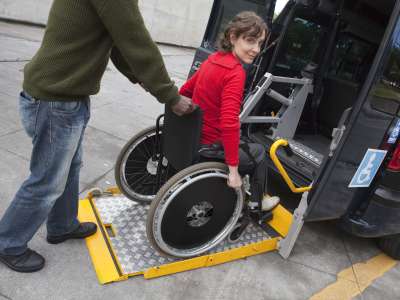
I qualified as an occupational therapist in 2005 and have worked in the NHS since. In 2019 I joined the Warrington wheelchair service as a Band 6 therapist. Attending the PMG Conference 2019 enabled me to develop my knowledge and skills on best practice for effective assessment and wheelchair provision, which I intend to implement within my wheelchair service going forward.
I attended the breakout session on Best Practice Guidelines for Transportation (BPG1) revision 2019, led by Bob Appleyard and Paul Dryer. Bob is a technical safety advisor/crash test engineer and was commissioned by PMG in 2018 to update the guidelines for wheelchair-seated passenger transport which were first published in 2013. The document sets out to help identify important gaps in information not always provided by manufacturers.
Various safety scenarios were discussed during the presentation, and photographic evidence of collisions involving wheelchair accessible vehicles were reviewed. One example shown, where advice wasn’t followed in terms of the use of the tie down points, demonstrated the possible devastating outcome when not done correctly.
The reviewing process was also discussed. This had involved creating an expert review panel, and gathering feedback and comments on the document via the PMG website. The role of the review panel was to analyse these comments from differing expertise and areas of the industry. A table of comments was then compiled in a standardised format used by the International Organization for Standardisation (ISO) and the British Standards Institute (BSI) which includes a column for proposed correction.
Crash test standards for wheelchairs is under review and a proposed amendment is that a symbol should be attached to the wheelchair that indicates it has been crash tested. This was a suggestion from the commenting process, and an example of how comments were incorporated. It was suggested also that the symbol indicates that the wheelchair would preferably be forward facing during transportation, as recommended in the guidelines.
It became apparent through the commenting process that this BPG is being accessed by a broad base of readers, such as transport providers and procurement personnel, all of whom influenced the revised document. It was also evident that readers had found it difficult to navigate the original 42-page document to find the relevant information that they required.
Originally the document was in four sections and it is now seven sections. Hyperlinks have been integrated into the document, hopefully leading to quick access to relevant sections for the reader.
The complexity of crash tests, including the testing of variables like degrees of tilt and recline, and other external forces such as road vibrations and risk management, was also discussed during the session. The importance of minimising risk was highlighted, for example reducing the tilt of a passenger as much as possible. Head supports from a transport perspective have their own crash testing, and it has to be understood that the head support is only capable of offering a certain degree of protection. During the presentation Bob illustrated the optimum position of the headrest to achieve this, as highlighted in the guidelines.
Up until now guidelines have concentrated on occupants of 22 kg upwards, but the issues of paediatric and bariatric occupants are now addressed, as well as how to secure these occupants in the vehicle effectively.
Smaller occupants
The current standard is under revision.
Bariatric occupants
Crash testing bariatric equipment has its own challenges. The session explained that the test platform during crash testing had to be extended to accommodate the wheelchairs in the test centre, and the 95th percentile required a different crash testing facility. It is suggested that for bariatric occupants the restraint system is discussed with the manufacturer directly to explore suitability.
Effective occupant restraint
The effectiveness of integrated belts and benefits of positioning to avoid abdominal intrusion was discussed, and there are images in the document to demonstrate effective use of occupant restraints.
Wheelchair securement
The guidelines also include a discussion of wheelchair weight limit; tie down requirements and docking systems are also explored.
There is an updated section on risk management and transport, and this is now separate from medical devices. It covers interagency working, such as wheelchair prescribers and transport providers working together.
A transport hazard checklist is included and is a useful tool. There is also the introduction of the Wheelchair Passport which collates information about best practice in transport relating to a particular wheelchair . There are various different formats of the passport currently, and some electronic versions are under construction e.g. use of bar codes.
NB The revised document is available for download via the PMG website BPG section here.
I found attending the PMG Conference 2019 to be a highly educational experience and an excellent networking opportunity. I would like to take this opportunity to thank PMG for providing me with a bursary to attend, and look forward to implementing all the knowledge gained within the Warrington Wheelchair Service and in further service development






.jpg)



no comments
Add your comment...